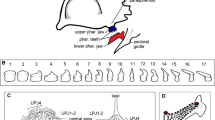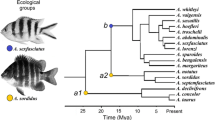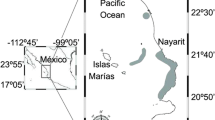Abstract
Piscivory is a significant ecosystem function on coral reefs, with up to 53% of species on reefs being regarded as piscivorous. Despite this ecological importance, the species that contribute to this function have not been assessed in a broad comparative, morphological context. We therefore conducted a morphological assessment of piscivorous coral reef fishes based on a comparative analysis of 119 species, linking morphology with ecological traits (habitat and activity). After accounting for phylogenetic relationships, we found that head length, premaxilla–maxilla (pmx–mx) length, body depth, and eye size mark the primary axis of variation among species. Pmx–mx length is strongly correlated with both vertical and horizontal gape size. We identify three distinct ecomorphotypes: diurnal benthic, nocturnal, and pelagic piscivores. Benthic diurnal and nocturnal piscivores display a wide array of pmx–mx lengths, potentially reflecting the large array of prey sizes and shapes in benthic habitats. This diversity highlights the potential for niche partitioning based on maximum ingestible prey sizes. By comparison, pmx–mx lengths in pelagic piscivores are more restricted, suggesting limited variance in prey sizes or restrictions associated with their feeding mode. Fin shape was also a primary driver of variation between benthic and pelagic predators. The ecomorphotype of nocturnal piscivores suggests that although they are benthic-associated during daytime, these forms leave the reef at night to feed in more open habitats. When analyzing diurnal benthic piscivores alone, we found a major axis of variation between deep-bodied piscivores with large gapes and large head lengths versus fusiform piscivores with high fin aspect ratio values. This continuum appears to describe the relative strength of benthic associations. Overall, we provide a broad quantitative framework for understanding the morphology and potential functions of piscivorous fishes on coral reefs.



Similar content being viewed by others
References
Albins MA, Hixon MA (2008) Invasive Indo-Pacific lionfish Pterois volitans reduce recruitment of Atlantic coral-reef fishes. Marine Ecology Progress Series 367:233–238
Alfaro ME, Faircloth BC, Harrington RC, Sorenson L, Friedman M, Thacker CE, Oliveros CH, Černý D, Near TJ (2018) Explosive diversification of marine fishes at the Cretaceous–Palaeogene boundary. Nature ecology & evolution 1
Allen GR (1985) FAO species catalogue vol. 6 snappers of the world: an annotated and illustrated catalogue of Lutjanid species known to date. Food and Agriculture Organization of the United Nations
Almany GR (2004a) Priority effects in coral reef fish communities of the Great Barrier Reef. Ecology 85:2872–2880
Almany GR (2004b) Differential effects of habitat complexity, predators and competitors on abundance of juvenile and adult coral reef fishes. Oecologia 141:105–113
Almany GR, Webster MS (2004) Odd species out as predators reduce diversity of coral-reef fishes. Ecology 85:2933–2937
Appeldoorn R, Aguilar-Perera A, Bouwmeester B, Dennis G, Hill R, Merten W, Recksiek C, Williams S (2009) Movement of fishes (Grunts: Haemulidae) across the coral reef seascape: a review of scales, patterns and processes. Caribbean Journal of Science 45:304–316
Bellwood DR, Wainwright PC (2002) The history and biogeography of fishes on coral reefs. Coral reef fishes: dynamics and diversity in a complex ecosystem:5–32
Bellwood DR, Hughes TP, Hoey AS (2006) Sleeping functional group drives coral-reef recovery. Current Biology 16:2434–2439
Bellwood DR, Streit RP, Brandl SJ, Tebbett SB (2019) The meaning of the term ‘function’ in ecology: a coral reef perspective. Functional Ecology
Bellwood DR, Tebbett SB, Bellwood O, Mihalitsis M, Morais RA, Streit RP, Fulton CJ (2018) The role of the reef flat in coral reef trophodynamics: past, present, and future. Ecology and evolution 8:4108–4119
Brandl SJ, Tornabene L, Goatley CHR, Casey JM, Morais RA, Côté IM, Baldwin CC, Parravicini V, Schiettekatte NMD, Bellwood DR (2019) Demographic dynamics of the smallest marine vertebrates fuel coralreef ecosystem functioning. Science
Choat J, Bellwood D (1991) Reef fishes: their history and evolution. In: The ecology of fishes on coral reefs. Elsevier, pp 39–66
Cinner JE, McClanahan TR, Graham NA, Pratchett MS, Wilson SK, Raina JB (2009) Gear-based fisheries management as a potential adaptive response to climate change and coral mortality. Journal of Applied Ecology 46:724–732
Claverie T, Wainwright PC (2014) A morphospace for reef fishes: elongation is the dominant axis of body shape evolution. PLoS One 9:e112732
Collette BB, Nauen CE (1983) FAO species catalogue. Volume 2. Scombrids of the world. An annotated and illustrated catalogue of tunas, mackerels, bonitos and related species known to date
Darwin CR (1859) On the origin of species by means of natural selection, or the preservation of favoured races in the struggle for life, London
Domenici P, Wilson A, Kurvers R, Marras S, Herbert-Read JE, Steffensen JF, Krause S, Viblanc P, Couillaud P, Krause J (2014) How sailfish use their bills to capture schooling prey. Proceedings of the Royal Society of London B: Biological Sciences 281:20140444
Drucker EG, Walker JA, Westneat MW (2005) Mechanics of pectoral fin swimming in fishes Fish Physiology, pp 369–423
Estes JA, Terborgh J, Brashares JS, Power ME, Berger J, Bond WJ, Carpenter SR, Essington TE, Holt RD, Jackson JB (2011) Trophic downgrading of planet Earth. science 333:301–306
Frédérich B, Marrama G, Carnevale G, Santini F (2016) Non-reef environments impact the diversification of extant jacks, remoras and allies (Carangoidei, Percomorpha). Proc R Soc B 283:20161556
Froese R, Pauly D (2010) FishBase. Fisheries Centre, University of British Columbia
Fulton C (2007) Swimming speed performance in coral reef fishes: field validations reveal distinct functional groups. Coral Reefs 26:217–228
Fulton C, Bellwood D, Wainwright P (2005) Wave energy and swimming performance shape coral reef fish assemblages. Proceedings of the Royal Society of London B: Biological Sciences 272:827–832
Fulton CJ, Bellwood DR (2005) Wave-induced water motion and the functional implications for coral reef fish assemblages. Limnology and Oceanography 50:255–264
Fulton CJ, Wainwright PC, Hoey AS, Bellwood DR (2017) Global ecological success of Thalassoma fishes in extreme coral reef habitats. Ecology and evolution 7:466–472
Goatley CHR, Bellwood DR (2016) Body size and mortality rates in coral reef fishes: a three-phase relationship. Proc R Soc B 283:20161858
Goldman B, Talbot FH, Jones O, Endean R (1976) Aspects of the ecology of coral reef fishes. Biology and geology of coral reefs 3:125–154
Grafen A (1989) The phylogenetic regression. Phil Trans R Soc Lond B 326:119–157
Graham N, Dulvy N, Jennings S, Polunin N (2005) Size-spectra as indicators of the effects of fishing on coral reef fish assemblages. Coral Reefs 24:118–124
Grubich JR, Rice AN, Westneat MW (2008) Functional morphology of bite mechanics in the great barracuda (Sphyraena barracuda). Zoology 111:16–29
Habegger ML, Dean MN, Dunlop JW, Mullins G, Stokes M, Huber DR, Winters D, Motta PJ (2015) Feeding in billfishes: inferring the role of the rostrum from a biomechanical standpoint. Journal of Experimental Biology:jeb. 106146
Harmon LJ, Weir JT, Brock CD, Glor RE, Challenger W (2007) GEIGER: investigating evolutionary radiations. Bioinformatics 24:129–131
Heemstra PC, Randall JE (1993) Groupers of the world. FAO Fisheries synopsis 16:I
Hemingson CR, Bellwood DR (2018) Biogeographic patterns in major marine realms: function not taxonomy unites fish assemblages in reef, seagrass and mangrove systems. Ecography 41:174–182
Hiatt RW, Strasburg DW (1960) Ecological relationships of the fish fauna on coral reefs of the Marshall Islands. Ecological Monographs 30:65–127
Hinchliff CE, Smith SA, Allman JF, Burleigh JG, Chaudhary R, Coghill LM, Crandall KA, Deng J, Drew BT, Gazis R (2015) Synthesis of phylogeny and taxonomy into a comprehensive tree of life. Proceedings of the National Academy of Sciences 112:12764–12769
Hixon MA (1991) Predation as a process structuring coral-reef fish communities. The ecology of fish on coral reefs
Hobson ES (1965) Diurnal-nocturnal activity of some inshore fishes in the Gulf of California. Copeia:291–302
Hobson ES (1972) Activity of Hawaiian reef fishes during the evening and morning transitions between daylight and darkness. Fishery Bulletin 70:715–740
Jackson JB, Kirby MX, Berger WH, Bjorndal KA, Botsford LW, Bourque BJ, Bradbury RH, Cooke R, Erlandson J, Estes JA (2001) Historical overfishing and the recent collapse of coastal ecosystems. science 293:629–637
Jennings S, Polunin N (1997) Impacts of predator depletion by fishing on the biomass and diversity of non-target reef fish communities. Coral reefs 16:71–82
Kerry J, Bellwood D (2015) The functional role of tabular structures for large reef fishes: avoiding predators or solar irradiance? Coral Reefs 34:693–702
Khan J, Welsh J, Bellwood D (2016) Using passive acoustic telemetry to infer mortality events in adult herbivorous coral reef fishes. Coral Reefs 35:411–420
Khan JA, Goatley CH, Brandl SJ, Tebbett SB, Bellwood DR (2017) Shelter use by large reef fishes: long-term occupancy and the impacts of disturbance. Coral Reefs 36:1123–1132
Leray M, Boehm J, Mills SC, Meyer C (2012) Moorea BIOCODE barcode library as a tool for understanding predator–prey interactions: insights into the diet of common predatory coral reef fishes. Coral reefs 31:383–388
Longo SJ, McGee MD, Oufiero CE, Waltzek TB, Wainwright PC (2016) Body ram, not suction, is the primary axis of suction-feeding diversity in spiny-rayed fishes. Journal of Experimental Biology 219:119–128
Marnane MJ, Bellwood DR (2002) Diet and nocturnal foraging in cardinalfishes (Apogonidae) at one tree reef, great barrier reef, Australia. Marine Ecology progress series 231:261–268
Michonneau F, Brown JW, Winter DJ (2016) rotl: an R package to interact with the Open Tree of Life data. Methods in Ecology and Evolution 7:1476–1481
Mihalitsis M, Bellwood DR (2017) A morphological and functional basis for maximum prey size in piscivorous fishes. PloS one 12:e0184679
Morais RA, Bellwood DR (2019) Pelagic Subsidies Underpin Fish Productivity on a Degraded Coral Reef. Current Biology
Morris JA, Akins JL (2009) Feeding ecology of invasive lionfish (Pterois volitans) in the Bahamian archipelago. Environmental Biology of Fishes 86:389
Motta PJ, Norton SF, Luczkovich JJ (1995) Perspectives on the ecomorphology of bony fishes. Environmental Biology of Fishes 44:11–20
Myers RA, Worm B (2003) Rapid worldwide depletion of predatory fish communities. Nature 423:280
Newman SJ, Williams DM (2001) Spatial and temporal variation in assemblages of Lutjanidae, Lethrinidae and associated fish species among mid-continental shelf reefs in the central Great Barrier Reef. Marine and Freshwater Research 52:843–851
Norton SF, Luczkovich JJ, Motta PJ (1995) The role of ecomorphological studies in the comparative biology of fishes. Environmental biology of fishes 44:287–304
Oksanen J, Blanchet FG, Kindt R, Legendre P, Minchin PR, O’hara R, Simpson GL, Solymos P, Stevens MHH, Wagner H (2013) Package ‘vegan’. Community ecology package, version 2
Oufiero CE, Holzman RA, Young FA, Wainwright PC (2012) New insights from serranid fishes on the role of trade-offs in suction-feeding diversification. Journal of Experimental Biology 215:3845–3855
Paradis E, Claude J, Strimmer K (2004) APE: analyses of phylogenetics and evolution in R language. Bioinformatics 20:289–290
Pauly D, Christensen V, Dalsgaard J, Froese R, Torres F (1998) Fishing down marine food webs. Science 279:860–863
Pinheiro J, Bates D, DebRoy S, Sarkar D (2014) R Core Team (2014) nlme: linear and nonlinear mixed effects models. R package version 3.1-117. Available at http://CRAN.R-project.org/package=nlme
R Core Team (2017) R: A language and environment for statistical computing. R Foundation for Statistical Computing, Vienna, Austria
Randall JE (1967) Food habits of reef fishes of the West Indies
Randall JE (2005) Reef and shore fishes of the South Pacific: New Caledonia to Tahiti and the Pitcairn Islands
Randall JE, Allen GR, Steene RC (1997) Fishes of the great barrier reef and coral sea. University of Hawaii Press
Revell LJ (2009) Size-correction and principal components for interspecific comparative studies. Evolution 63:3258–3268
Russ GR, Alcala AC (1989) Effects of intense fishing pressure on an assemblage of coral reef fishes. Marine Ecology Progress Series:13–27
Sambilay VC Jr (1990) Interrelationships between swimming speed, caudal fin aspect ratio and body length of fishes. Fishbyte 8:16–20
Scott W, Tibbo S (1968) Food and feeding habits of swordfish, Xiphias gladius, in the western North Atlantic. Journal of the Fisheries Board of Canada 25:903–919
St. John J (1999) Ontogenetic changes in the diet of the coral reef grouper Plectropomus leopardus (Serranidae): patterns in taxa, size and habitat of prey. Marine Ecology Progress Series:233–246
Svendsen MB, Domenici P, Marras S, Krause J, Boswell KM, Rodriguez-Pinto I, Wilson AD, Kurvers RH, Viblanc PE, Finger JS (2016) Maximum swimming speeds of sailfish and three other large marine predatory fish species based on muscle contraction time and stride length: a myth revisited. Biology open 5:1415–1419
Sweatman HP (1984) A field study of the predatory behavior and feeding rate of a piscivorous coral reef fish, the lizardfish Synodus englemani. Copeia:187–194
Turingan RG (1994) Ecomorphological relationships among Caribbean tetraodontiform fishes. Journal of Zoology 233:493–521
Wainwright PC (1988) Morphology and ecology: functional basis of feeding constraints in Caribbean labrid fishes. Ecology 69:635–645
Wainwright PC (1991) Ecomorphology: experimental functional anatomy for ecological problems. American Zoologist 31:680–693
Wainwright PC, Richard BA (1995) Predicting patterns of prey use from morphology of fishes. Environmental Biology of Fishes 44:97–113
Wainwright PC, Bellwood D (2002) Ecomorphology of Feeding in Coral Reef Fishes. In: Peter S (ed) Coral reef fishes: dynamics and diversity in a complex ecosystem, pp 33
Wainwright PC, Bellwood DR, Westneat MW (2002) Ecomorphology of locomotion in labrid fishes. Environmental Biology of Fishes 65:47–62
Walker JA (2004) Kinematics and performance of maneuvering control surfaces in teleost fishes. IEEE Journal of Oceanic Engineering 29:572–584
Wardle C, Videler J, Arimoto T, Franco J, He P (1989) The muscle twitch and the maximum swimming speed of giant bluefin tuna, Thunnus thynnus L. Journal of fish biology 35:129–137
Acknowledgements
We thank L. Baraf, P. Cowman, C. Hemingson, V. Huertas, R. Morais, A. Siqueira, R. Streit, and S. Tebbett for insightful discussions and statistical advice; K. Hillcoat and J. Lowe for fish specimens, J.E. Randall for making freely available the photos used in our study, and two anonymous reviewers for helpful comments on the manuscript which was supported by the Australian Research Council (DRB).
Funding
Funding was provided by Centre of Excellence for Coral Reef Studies, Australian Research Council (AU) (Grant No. CE140100020).
Author information
Authors and Affiliations
Corresponding author
Ethics declarations
Ethics
All measurements were carried out in accordance with the James Cook University Animal Ethics Committee (A2529).
Conflict of interest
On behalf of all authors, the corresponding author states that there is no conflict of interest.
Additional information
Topic Editor Morgan S. Pratchett
Publisher's Note
Springer Nature remains neutral with regard to jurisdictional claims in published maps and institutional affiliations.
Electronic supplementary material
Below is the link to the electronic supplementary material.
Rights and permissions
About this article
Cite this article
Mihalitsis, M., Bellwood, D.R. Morphological and functional diversity of piscivorous fishes on coral reefs. Coral Reefs 38, 945–954 (2019). https://doi.org/10.1007/s00338-019-01820-w
Received:
Accepted:
Published:
Issue Date:
DOI: https://doi.org/10.1007/s00338-019-01820-w




